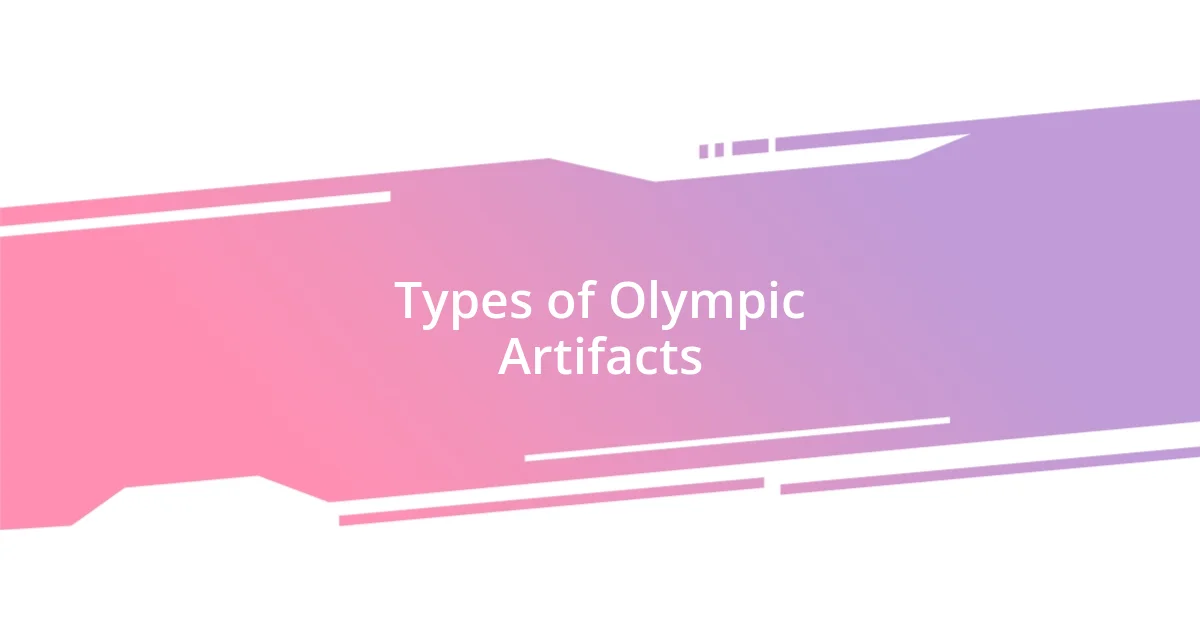Key takeaways:
- Olympic artifacts encapsulate the spirit of competition and cultural history, acting as educational tools and fostering a sense of community and shared identity.
- Different types of artifacts, such as medals, uniforms, and archival documents, provide valuable insights into the evolution of sports, athlete experiences, and the influence of the Olympic Games on society.
- Preservation of these artifacts is essential to maintaining their significance, with community involvement playing a crucial role in safeguarding the legacy of the Olympics for future generations.

Introduction to Olympic Artifacts
Olympic artifacts are more than just old relics; they embody the spirit of competition, perseverance, and the rich history that the Games represent. I remember visiting a small museum dedicated to the Olympics, where each item told a story—like an athlete’s worn-out shoes or a medal that shimmered with dreams of glory. It makes you wonder, how many lives have these artifacts touched over the years?
As I dug deeper into this fascinating world, I found myself captivated by the emotions these objects evoke. Imagine the dedication of an athlete who trained tirelessly, their sweat and sacrifices woven into every fiber of their gear. These artifacts are poignant reminders of human achievement and resilience—do you feel that connection when you see them?
Interestingly, each Olympic artifact serves as a snapshot of its time, preserving societal values, technological advances, and cultural shifts. Exploring them allows us a glimpse into history, enriching our understanding of not just the Games but the world at large. What stories will you uncover as you dive into the universe of Olympic relics?

Importance of Olympic Artifacts
Olympic artifacts hold immense importance as they encapsulate the essence of diverse cultures and the evolution of Olympic traditions. Each piece represents not only a moment frozen in time but also a connection to the athletes who poured their hearts and souls into their performance. Visiting a display of ancient Olympic artifacts, I felt an overwhelming sense of respect for the dedication of those who competed long ago. It made me ponder how these objects can inspire and connect generations.
- They serve as educational tools, offering insights into the history of the Games and the social dynamics of different eras.
- Each artifact tells a unique story, revealing the triumphs and challenges faced by athletes.
- They foster a sense of community by allowing fans and historians to share in the legacy of the Olympics.
- Analyzing these items can spark discussions about ethical considerations and the future of sports.
- Finally, they are a source of pride for nations, celebrating both collective and individual achievements on the world stage.
Finding artifacts from my own country’s Olympic past felt like uncovering a hidden treasure. I was astonished to see items that had once been part of historic victories and struggles, and it reminded me that while sport brings competition, it also fosters unity and shared identity. Each artifact is a portal into narratives that shape our understanding of human endeavor and passion.

Types of Olympic Artifacts
Olympic artifacts can be categorized into several distinct types, each offering unique insights into the history of the Games. For instance, medals symbolize achievement and honor, capturing the essence of victory. I still recall the excitement of seeing a gold medal up close for the first time at an exhibit—the way it gleamed under the lights was breathtaking, telling a story of triumph and years of hard work. On the other hand, equipment such as uniforms and sports gear provides a glimpse into the evolution of sports technology and athlete preparation over time.
Another fascinating category includes promotional materials and memorabilia, like posters and tickets. I remember browsing through old tickets from the 1984 Olympics; it felt like holding history in my hands. Each item, whether a ticket stub or a team poster, encapsulates the spirit of the event and evokes memories of the times they represent. Moreover, art created for the Olympics—murals, sculptures, and even fashion—adds a cultural layer to our understanding, showcasing how the Games influence and are influenced by the arts.
Lastly, there are archival documents, including photographs and personal letters from athletes. One particular photograph I came across, depicting a celebrated athlete mid-action, stirred emotions I can’t quite describe. It wasn’t just a photo; it was a moment frozen in time, capturing raw determination and passion. Each type of artifact contributes to the rich tapestry of Olympic history, allowing us to appreciate the myriad stories behind the Games.
| Type of Artifact | Description |
|---|---|
| Medals | Symbolize achievement and honor |
| Equipment | Includes uniforms and sports gear, showcasing technological evolution |
| Promotional Materials | Tickets, posters, and memorabilia that evoke the spirit of the event |
| Archival Documents | Photographs and personal letters from athletes that capture moments in time |

Significant Discoveries in Olympic Artifacts
When examining significant discoveries in Olympic artifacts, I’m often struck by the profound connections these items create with the past. For instance, I once stood in awe before a trophy awarded at the 1936 Berlin Olympics. The weight of history echoed as I pondered the struggles and triumphs encapsulated in that singular object. Can you imagine the stories it could tell if it could speak?
A striking discovery I learned about was a collection of early Olympic torches from the 1936 Games. Each torch not only represents the spirit of the Olympics but also serves as a reminder of the cultural and political contexts of that era. I found it fascinating that something as simple as a torch can spur thoughts about the ideals of peace and friendship amidst turbulent times. Isn’t it incredible how an object’s significance can transcend its physical form?
Another remarkable find that left a lasting impression on me was a uniform worn by a pioneering female athlete. The fabric, worn and faded, told a silent story of determination and breaking barriers. It made me reflect on the challenges women faced in sports and how far we’ve come. It raises the question: what stories do current athletes’ uniforms carry for future generations? Each discovery allows us to engage in conversations about identity, resilience, and the evolution of sporting ideals.

Preservation of Olympic Artifacts
The preservation of Olympic artifacts is crucial for maintaining the rich history of the Games. I remember visiting a museum where they showcased an entire section dedicated to carefully conserved items. Each piece, from medals to uniforms, was encapsulated in climate-controlled glass cases. It felt like stepping into a sacred space where time stood still, allowing us to appreciate their significance.
The strategies used for preservation are as fascinating as the artifacts themselves. Professional conservators use techniques like archival storage and digital documentation to prevent deterioration. I once watched a conservator meticulously clean a copper Olympic medal. The care taken made me realize how fragile history can be; it’s a reminder that even the most celebrated symbols of victory require vigilance to survive the test of time.
Another aspect that captures my attention is community involvement in artifact preservation. I participated in an event where local sports teams brought their memorabilia to be preserved. Engaging with athletes and hearing their stories added depth to the artifacts they brought. It was heartwarming to see how passion for the Olympics extends beyond individual experiences; it’s a collective responsibility to safeguard these treasures. Have you ever considered how our shared commitment can influence future generations? Every effort can spark a connection between past and present, ensuring that the Olympic spirit endures.

Analyzing Olympic Artifacts
Analyzing Olympic artifacts reveals a tapestry of human experience, woven with triumphs and challenges. For instance, I recall my fascination when studying a vintage Olympic ticket from the 1960 Rome Games while reviewing a collection. The faded ink and slight creases whispered tales of spectators, enthusiasm, and a rich cultural atmosphere that can be felt even decades later. Have you ever considered how a mere ticket encapsulates the excitement of a global event, linking countless individuals across time?
One artifact that sparked my curiosity was a collection of victory wreaths from various Olympics. Each wreath, crafted from laurel leaves, was not just a symbol of victory but also a reflection of the athletes’ journeys. Holding one in my hands, I could almost feel the emotions of the moment it adorned a champion’s head—joy, pride, and the culmination of years of hard work. Isn’t it captivating how such a simple item can evoke such powerful feelings?
Delving into the stories behind Olympic medals also offers profound insights into the spirit of competition. I vividly remember examining a medal from the 1984 Los Angeles Games and learning about the athlete who received it. Their struggles, sacrifices, and ultimate victory transformed that shiny piece of metal into an emblem of perseverance. Analyzing artifacts like these invites us to not only appreciate their beauty but to also honor the legacy of those who competed, reminding us of the human stories behind every medal.












